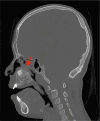Anesthetic Management of a Pediatric Patient With Pfeiffer Syndrome
- PMID: 39503147
- PMCID: PMC11387965
- DOI: 10.2344/523400
Anesthetic Management of a Pediatric Patient With Pfeiffer Syndrome
Abstract
Pfeiffer syndrome (PS) is a rare inherited disorder that affects the craniofacial and extremity bones but can also include anomalies of the upper and lower airways. Among the 3 subtypes, PS types 2 and 3 are the most severe. We describe the anesthetic management of a 10-year-old boy with PS type 2 scheduled for dental treatment under general anesthesia. Because of his history of Chiari malformation, avoiding neck hyperextension was recommended to prevent worsening of his neurologic function. Preoperative computed tomography revealed significant nasal stenosis but no tracheal anomalies. Considering the difficulty of nasotracheal intubation, we planned for an oral intubation. General anesthesia was induced using sevoflurane, nitrous oxide, and oxygen along with an oropharyngeal airway. After lidocaine was topically applied to the oropharynx, fiber-optic orotracheal intubation was performed under spontaneous ventilation to minimize head and neck movement. Anesthesia was maintained using desflurane and remifentanil, and no postoperative complications were observed. General anesthesia for patients with PS requires careful planning, which should include preoperative assessment of the airway to determine the feasibility of nasotracheal intubation and identify airway irregularities.
Keywords: Airway management; Craniosynostosis; General anesthesia; Pfeiffer syndrome.
Figures
References
-
- Pfeiffer RA Dominant hereditary acrocephalosyndactylia. Z Kinderheilkd. 1964;90:301–320. - PubMed
-
- Schell U, Hehr A, Feldman GJ, et al. Mutations in FGFR1 and FGFR2 cause familial and sporadic Pfeiffer syndrome. Hum Mol Genet. 1995;4:323–328. - PubMed
-
- Fearon JA, Rhodes J Pfeiffer syndrome: a treatment evaluation. Plast Reconstr Surg. 2009;123:1560–1569. - PubMed
-
- Cohen MM Jr. Pfeiffer syndrome update, clinical subtypes, and guidelines for differential diagnosis. Am J Med Genet. 1993;45:300–307. - PubMed
Publication types
MeSH terms
Substances
LinkOut - more resources
Full Text Sources


